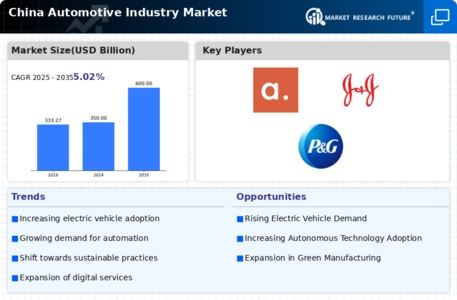Market Analysis
In-depth Analysis of China Automotive Industry Market Industry Landscape
The market dynamics of the automotive industry in China reflect a complex and rapidly evolving landscape, influenced by a combination of economic, technological, and policy-driven factors. China has emerged as the world's largest automotive market, driven by a massive population, rising middle-class consumer demand, and government initiatives to promote the development of the domestic automotive sector.
One key driver of the market dynamics is the sheer size and diversity of the Chinese consumer base. The country's rapidly growing middle class has led to increased demand for private vehicles, driving robust sales for both domestic and international automotive manufacturers. The variety of consumer preferences across different regions within China has also given rise to a diverse market, with demand for various vehicle types, including sedans, SUVs, electric vehicles (EVs), and new energy vehicles (NEVs).
Government policies and regulations have played a significant role in shaping the automotive market dynamics in China. To address environmental concerns and reduce dependence on fossil fuels, the Chinese government has implemented policies incentivizing the production and purchase of electric vehicles. Subsidies, tax breaks, and license plate restrictions for traditional internal combustion engine vehicles have contributed to the rapid growth of the electric vehicle market, making China a global leader in EV adoption.
Technological advancements and innovation have been driving forces in the dynamics of the Chinese automotive industry. The country is investing heavily in research and development, focusing on areas such as autonomous driving, connectivity, and smart vehicle technologies. Chinese automotive companies, both established and startups, are actively collaborating with tech firms to integrate advanced features into their vehicles, catering to the tech-savvy preferences of the Chinese consumer base.
The automotive market dynamics in China are also influenced by the country's commitment to becoming a global leader in new energy vehicles. The push for electric and hybrid vehicles is not only driven by environmental considerations but also aligns with China's goal to reduce its reliance on imported oil. The government's promotion of NEVs includes incentives for manufacturers, subsidies for consumers, and the establishment of charging infrastructure, creating a conducive environment for the growth of the electric vehicle market.
Joint ventures and partnerships between international and domestic automotive companies have been a notable aspect of the market dynamics in China. Many international automakers have formed alliances with local Chinese companies to navigate regulatory complexities, leverage local market insights, and gain access to the vast consumer base. These collaborations have facilitated technology transfer, allowing Chinese manufacturers to enhance their capabilities and compete on a global scale.
Supply chain dynamics and manufacturing capacity also play a crucial role in shaping the automotive market in China. The country has become a global manufacturing hub, with a well-established network of suppliers and production facilities. This enables efficient production and cost-effective manufacturing, contributing to the competitiveness of Chinese automotive products both domestically and in international markets.
Challenges such as regulatory uncertainties, trade tensions, and global economic fluctuations impact the market dynamics of the Chinese automotive industry. Changes in government policies, particularly those related to subsidies and incentives for the automotive sector, can have a significant impact on the market. Additionally, the industry is not immune to global economic trends, and fluctuations in demand for vehicles, both domestically and internationally, can influence production and sales within China.
The market dynamics of the automotive industry in China are characterized by a complex interplay of economic, technological, and policy-driven factors. The country's status as the world's largest automotive market, coupled with government initiatives, technological innovation, and strategic collaborations, positions China at the forefront of the global automotive landscape. The ongoing evolution of consumer preferences, regulatory frameworks, and global economic conditions will continue to shape the dynamic nature of the Chinese automotive market.














Leave a Comment